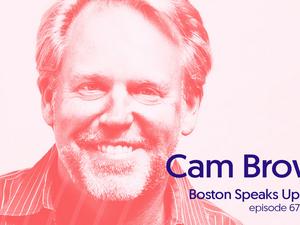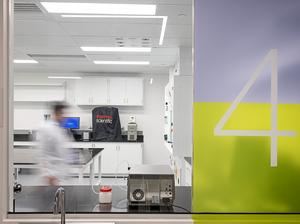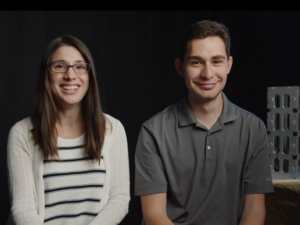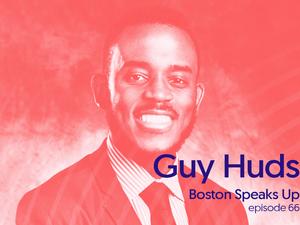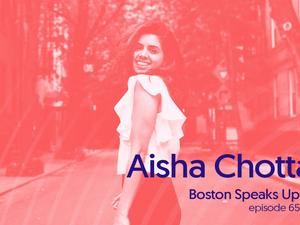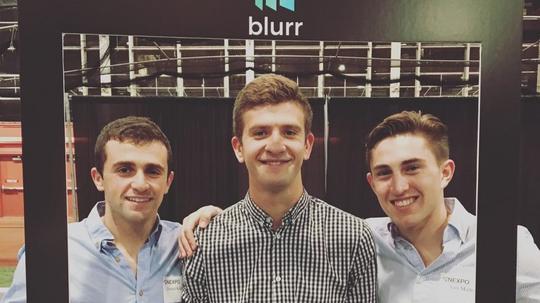
This is a First Look: It's the first time any news outlet or blog has covered this startup. You can read more First Looks here. (We do this a lot.)
Back in college, it seemed like every other person would be snapping pictures at parties - and yet, the resulting images - which were surely pure gems - were never to be seen afterwards. Or, you’d have to nag your friends, asking, “Did you put those pics on Facebook yet?” until the deed was done.
That problem hasn’t changed, apparently. After chatting with Daniel Arvidsson, Sam Marley and Daniel Korman - all students at Northeastern and founders of an upcoming app called Blurr - that issue persists today. Blurr's answer is to let people at the same place and time to take and share pictures, on a collective feed — so no one misses out on memories.
The app has gone through several iterations at this point - with help from Boston-based dev firm Northout - but the closed beta (Northeastern students only, sorry) has been pinned down for January and the team is planning on launching to the public in February.
It all started with a ripper
Arvidsson, Korman and Marely all met and became friends while playing on the soccer team at Northeastern. Following one fateful night, which included fellow Northeastern student and entrepreneur Elliot Mustoe (he founded LivCollege), the concept for Blurr came into place.
“Elliot was our roommate and we got the idea for Blurr after we threw him a going away party because he was going to study abroad in Australia,” Korman explained. “We had about 30 or 40 people in our apartment, and we all wanted to take pictures with him because he was going to be gone for months.”
“We were having breakfast the next morning - hungover, of course,” he laughed. “We were talking about how much fun the night before was and how we wanted to post pictures from the party to Instagram. But none of us had them.”
From that hungover, breakfast table conversation, these guys trekked out to the library in the middle of one of last year’s infamous snowstorms and worked out the initial framework for Blurr.
What does it do?
Here’s how Blurr works: You walk into an event - a house party, a concert, a sports game, wherever - you open the app and press “start Blurr.” You’re able to choose from two options with your Blurr, close or closer, which creates either a 100- or 200-meter radius from where you are. With that setting selected, every picture taken and posted through Blurr by someone in that area will auto-populate into a single, communal feed.
If you don’t really care about the photos coming from complete strangers, you can go into a subsection that features only images from your Facebook friends. However, there’s a catch - none of the photos, including those from people with whom you’re connected on Facebook, will have an attribution. So everything will be anonymously shared amongst folks partaking in the same experience at the same place.
At any point while you’re still within the radius of where you started your Blur, you are able to download any of the photos featured on the feed. And when you choose to end your Blurr or you end up leaving the radius, you have 24 hours to peruse the shared photos and save the ones you want. They will be yours forever, even if you didn’t take them.
Where it falls on the social media spectrum
Yes, Blurr is technically another social media channel on which you can post pictures. That said, it’s altering the approach that mainstream sites and apps take.
“It only connects users who are at the same place at the same time and lets them share photos of what’s happening - unlike Snapchat, Instagram and Facebook, which share them with everyone else who isn’t there, who you aren’t making memories with,” said Marley.
“We didn’t just make an app to make an app. We personally wanted the value of getting pictures that we normally wouldn’t get,” he added.
Essentially, Blurr is helping people - whether they know each other or not - make memories together. These guys are elated to get their app out to the public in a matter of months and they’re fully confident it’s going to be a hit. While I’m personally confident that Blurr will take off (the college community will eat it up, I maintain), they do face a bit of competition. Not to mention other geolocation-oriented social apps that have come before them didn’t catch on. Thus, a tiny seed of doubt is planted.
For one thing, during my conversation with the Blurr team, I couldn’t help but thinking, “Is this really different enough from Yeti?” (Yeti is an app that lets people within a particular college share photos of what’s happening on campus). So I asked them point blank what they thought about this potential competitor.
“The main difference would be the types of photos that are shared, I think,” Korman responded. “For that or Snapchat, it’s mostly selfies and drunk photos.”
Blurr, on the other hand, is more for people who want to show general highlights of any kind of event. Hot messes and alcohol not required.
In terms of similar predecessors, you could look at ventures like CO Everywhere and Nextdoor.
Boston-based CO Everywhere started off targeting consumers, allowing them to draw areas on a map so they can filter out social media based on those specific locations. That was poorly received by the public, and CO Everywhere ended up pivoting with its Ground Signal solution, which is strictly B2B.
Less similar but still bearing a slight resemblance to Blurr is Nextdoor, which has been very successful. The San Francisco company lets neighborhoods have an exclusive social network all to themselves - users have to produce proof that they live in a particular area. It’s no joke. Nextdoor has raised multiple rounds of funding - but it isn’t strictly photo-sharing, and its only similarity is that it’s filtered by location, so it might not be indicative of Blurr’s track.
But it should crush
What may be more emblematic of how Blurr will be received by college users is that the founders are so amped about it. They’ve been generating hype around the Northeastern community and, from there, they’re hoping it will spread from schools throughout Boston and then the country. The company has received a small amount of funding from Northeastern's IDEA program, and "development has been going very well," Arvidsson said.
“We’ve validated our idea ourselves,” said Arvidsson. “We saw how much it’s needed, how engaging it is and we’ve been able to spread the word throughout Northeastern and got great feedback on it ... Now we’re at a point where we have a clear plan and can really utilize the gap funding from IDEA to explode in Boston.”
Image via Blurr.
